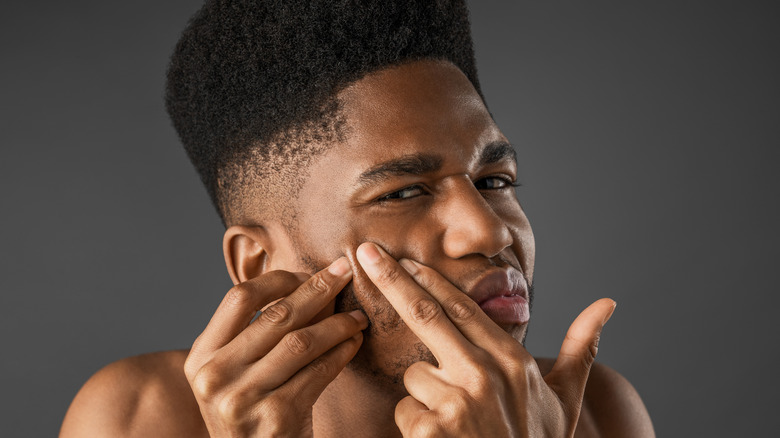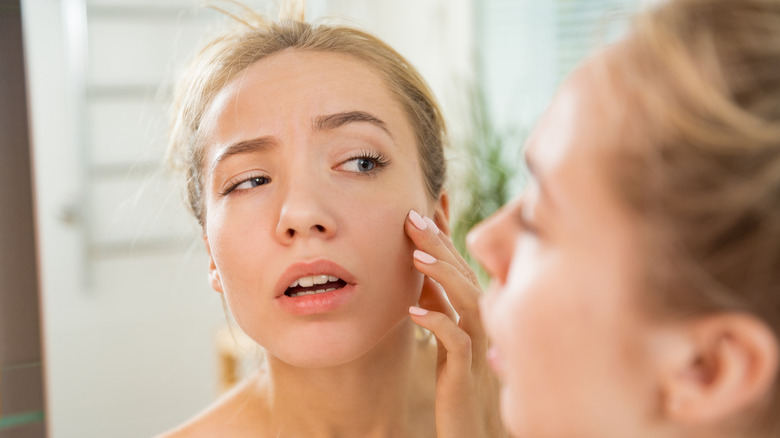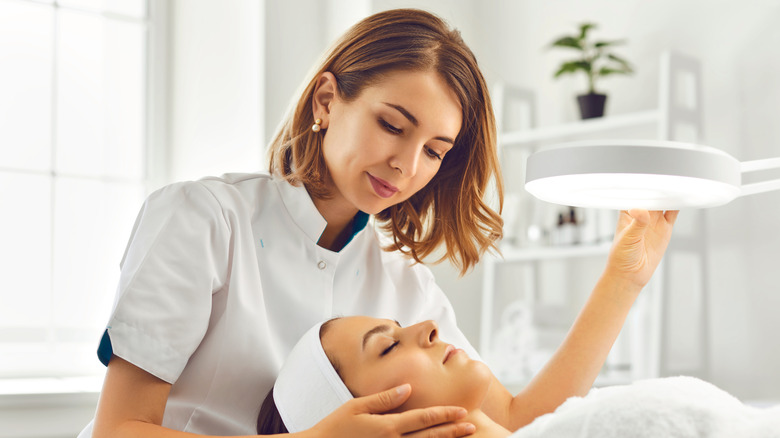Why Breakouts Are Often Painful
Pimples are very common, but that doesn't make them any less frustrating, embarrassing, and even painful. We've all been there. A stressful event leads to a cluster of pimples, or a hormonal week has your skin reacting with a breakout. There are many reasons why your skin may be acting up.
According to the Cleveland Clinic, pimples form when pores become blocked, and oil glands are clogged or inflamed. But what causes the pain and discomfort? Think of it as an alarm system for your skin that something doesn't belong. Pimples hurt because the body is trying to reject the buildup of toxins (per Epiphany Dermatology). The painful redness and swelling is your body's way of attempting to expel it. The worst thing you could do is interrupt its process by poking and prodding, no matter how tempting it may be.
In some cases, the breakout may not be visible on the skin's surface. This is known as a blind pimple, according to Healthline. Acne can also develop under the skin, causing hypersensitivity, redness, and pain. No matter the type of breakout, there are ways to effectively treat your skin.
How to soothe your breakout
Dermatologist Meghan Feely explains, telling the American Academy of Dermatology, "Although there are no overnight or immediate cures for acne, you don't have to stand by and suffer either."
There are steps you can take at home to make your pimples less painful. The first thing to do is to wash your face. "Make sure you use noncomedogenic and oil-free cosmetics, cleansers and sunscreens, and never try to scrub away a pimple, as this can further irritate it and make it worse," says Dr. Feely.
Next, you'll want to cool it down. By applying ice to the affected area for five to 10 minutes, you can reduce redness and swelling. Then you can apply over-the-counter acne products. The Mayo Clinic recommends benzoyl peroxide. The treatment kills bacteria and unclogs pores. It can be found at your local drugstore. Fair warning, benzoyl peroxide can bleach fabrics, so keep it away from clothes (via Mayo Clinic).
Once your pimple comes to a head (shows a visible white center), soak a clean washcloth in hot water and apply it to the pimple. The American Academy of Dermatology suggests doing this three to four times a day.
When to consult a doctor
If your at-home remedies don't do the trick, it may be time to call a professional. Mild breakouts can typically be cured with over-the-counter products, but severe cases should be handled with help from a dermatologist, per Verywell Health.
One sign it's time to call a doctor is if the breakout worsens. Give yourself four to six weeks of using drugstore products to clear the breakout. If it doesn't go away, consider requesting a prescription. Dr. Amy Derick, a dermatologist in Barrington, Illinois, tells WebMD, "Oral therapies like antibiotics, birth control, or isotretinoin can also be prescribed for deeper acne spots and hormonal breakouts."
If your breakouts affect your self-esteem and self-confidence, it's time to outsource solutions. Acne not only impacts appearance, but emotional health too (per the American Academy of Dermatology Association). According to the AADA, the longer breakouts last, the more likely it will take a toll on one's emotions. Unfortunately, the emotional stress can also worsen the breakouts.
"Today, virtually every case of acne can be successfully treated, even severe acne," Dr. Feely tells the AADA. "However, not everyone's acne can be treated the same way. If you have a lot of acne, or if your acne isn't responding to over-the-counter acne medications after four to six weeks, make an appointment to see a board-certified dermatologist."



